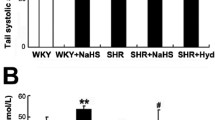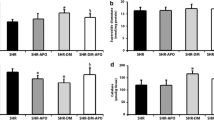Abstract
Cardiovascular disease has become one of the highest mortality diseases in the world. Single walled carbon nanotubes have acute effects on the muscles and lungs of spontaneously hypertensive rats. Inhalation of multi walled carbon nanotubes can cause subchronic injury to the muscles of the rats. Spontaneously hypertensive rats (SHR) are a good animal model of cardiovascular diseases, which exhibit similar properties to human hypertension. Therefore, in this study, the effects of carbon nanotubes on metabolism and oxidative stress in spontaneously hypertensive rats were studied. The results show that the early structural changes of cardiovascular tissue are independent of the formation of blood pressure, and there can be non-stress factors, leading to excessive structural remodeling. In group H and group L, the model of SHR rats was not passed after 7 days of administration, indicating that the two kinds of carbon nanotubes have little stimulation on SHR rats. After 30 days of administration, all the models failed, indicating that carbon nanotubes had no obvious chronic toxicity to cardiac metabolism in SHR rats. The increase of no content in SHR may be the mechanism of increased systolic blood pressure. The increase of iNOS and no in plasma may be related to the enhancement of oxidative stress after exposure to carbon nanotubes.




Similar content being viewed by others
Data availability statement
All data, models, and code generated or used during the study appear in the submitted manuscript.
References
Antikainen RL, Peters R, Beckett NS et al (2016) Left ventricular hypertrophy is a predictor of cardiovascular events in elderly hypertensive patients: hypertension in the very elderly trial. J Hypertens 34(11):2280–2286
Cao Y, Roursgaard M, Jacobsen NR et al (2016) Monocyte adhesion induced by multi-walled carbon nanotubes and palmitic acid in endothelial cells and alveolar-endothelial co-cultures. Nanotoxicology 10(2):235–244
Chakrabarti S, Kume H, Pan L et al (2016) Number of walls controlled synthesis of millimeter-long vertically aligned brushlike carbon nanotubes. J Phys Chem C 111(5):1929–1934
Chobanian AV (2017) Guidelines for the management of hypertension. Med Clin North Am 101(1):219–227
Coccini T, Roda E, Sarigiannis DA et al (2016) Effects of water-soluble functionalized multi-walled carbon nanotubes examined by different cytotoxicity methods in human astrocyte D384 and lung A549 cells. Toxicology 269(1):41–53
Cooper R (2018) Hypertension, genes, and environment: challenges for prevention and risk prediction. Circulation 137(7):662–664
Dionne JM, Harris KC, Benoit G et al (2017) Hypertension Canada’s 2017 guidelines for the diagnosis, assessment, prevention, and treatment of pediatric hypertension. Can J Cardiol 33(5):577–585
Ferrer ELI (2016) 2016 European Society of Hypertension guidelines for the management of high blood pressure in children and adolescents. Anales De Pediatría (engl Edn) 85(4):167–169
Fogari R, Zoppi A, Mugellini A et al (2016) Comparative efficacy of losartan and valsartan in mild-to-moderate hypertension: results of 24-hour ambulatory blood pressure monitoring. Curr Ther Res 60(4):195–206
Gao C, Muthukrishnan S, Li W et al (2016) Linear and hyperbranched glycopolymer-functionalized carbon nanotubes: synthesis, kinetics, and characterization. Macromolecules 40(6):1803–1815
Green AA, Hersam MC (2016) Colored semitransparent conductive coatings consisting of monodisperse metallic single-walled carbon nanotubes. Nano Lett 8(5):1417–1422
He L, Hu S, Jiang L et al (2017) Opposite effects of self-growth amorphous carbon and carbon nanotubes on the reforming of toluene with Ni/α-Al2O3 for hydrogen production. Int J Hydrogen Energy 42(21):14439–14448
Hutchinson PJ, Kolias AG, Timofeev IS et al (2016) Trial of decompressive craniectomy for traumatic intracranial hypertension. N Engl J Med 375(24):2401–2401
Iaccarino G (2016) AKT participates in endothelial dysfunction in hypertension. Circulation 109(21):2587–2593
Kalaitzidis RG, Elisaf MS (2018) Treatment of hypertension in chronic kidney disease. Curr Hypertens Rep 20(8):1–10
Lanzarini L, Fontana A, Campana C et al (2016) Two simple echo-Doppler measurements can accurately identify pulmonary hypertension in the large majority of patients with chronic heart failure. J Heart Lung Transplant 24(6):745–754
Li Z, Larsson JA, Larsson P et al (2016) Copper/molybdenum nanocomposite particles as catalysts for the growth of bamboo-structured carbon nanotubes. J Phys Chem C 112(32):12201–12206
Stamler R, Stamler J, Riedlinger WF et al (2016) Family (parental) history and prevalence of hypertension: results of a Nationwide Screening Program. JAMA 241(1):43–46
Stein JD, Brown GC, Brown MM et al (2016) The quality of life of patients with hypertension. J Clin Hypertens 4(3):181–188
Wang YQ, Sherwood PMA (2016) Studies of carbon nanotubes and fluorinated nanotubes by X-ray and ultraviolet photoelectron spectroscopy. Chem Mater 16(25):5427–5436
Wang H, Li S, Si Y et al (2016) Recyclable enzyme mimic of cubic Fe3O4 nanoparticles loaded on graphene oxide-dispersed carbon nanotubes with enhanced peroxidase-like catalysis and electrocatalysis. J Mater Chem B 2(28):4442–4448
Wen L, Li F, Cheng HM (2016) Carbon nanotubes and graphene for flexible electrochemical energy storage: from materials to devices. Adv Mater 28(22):4306–4337
Wu J, Hwang KC, Huang Y (2016) An atomistic-based finite-deformation shell theory for single-wall carbon nanotubes. J Mech Phys Solids 56(1):279–292
Yang J, Sun H, Liang H et al (2016) A highly efficient metal-free oxygen reduction electrocatalyst assembled from carbon nanotubes and graphene. Adv Mater 47(23):4606–4613
Zaporotskova IV, Boroznina NP, Parkhomenko YN et al (2016) Carbon nanotubes: sensor properties. A review. Mod Electron Mater 2(4):95–105
Author information
Authors and Affiliations
Corresponding author
Ethics declarations
Conflict of interest
No potential conflict of interest was reported by the author(s).
Additional information
Publisher's Note
Springer Nature remains neutral with regard to jurisdictional claims in published maps and institutional affiliations.
Rights and permissions
Springer Nature or its licensor (e.g. a society or other partner) holds exclusive rights to this article under a publishing agreement with the author(s) or other rightsholder(s); author self-archiving of the accepted manuscript version of this article is solely governed by the terms of such publishing agreement and applicable law.
About this article
Cite this article
Zhou, J., Dou, D., Qiu, W. et al. Effect of carbon nanotubes on metabolism and oxidative stress response in spontaneously hypertensive rat model. Appl Nanosci 13, 3551–3558 (2023). https://doi.org/10.1007/s13204-022-02723-z
Received:
Accepted:
Published:
Issue Date:
DOI: https://doi.org/10.1007/s13204-022-02723-z




